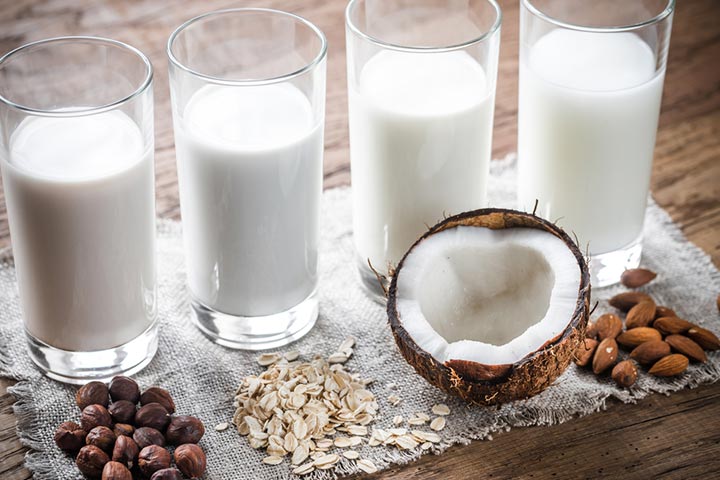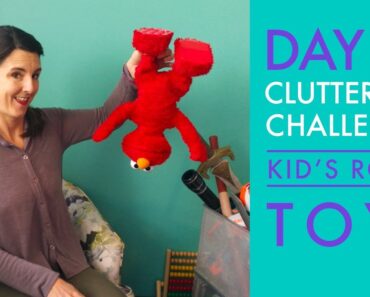Image: Shutterstock
Cow’s milk is the most common recommendation you would come across as soon as you are ready to wean off your baby from breast milk. Healthy babies older than one year can have whole cow milk as the primary beverage (1). But, if you are a vegan or your toddler has lactose intolerance or a milk allergy, then cow milk isn’t the suitable choice.
In such cases, contemplating other milk alternatives for toddlers becomes preeminent. However, choosing safe and healthy milk alternatives is complex. After all, not all milk types are nutritionally the same. So, how to decide which milk or milk alternative is suitable for your toddler?
Read on to get insight into several milk alternatives for toddlers and tips to feed these milk alternatives to your toddler safely.
Milk Alternatives For Babies And Toddlers
Milk Alternatives For Babies
The World Health Organization (WHO) recommends exclusive breastfeeding for babies up to six months of age. Then, a well-balanced, healthy weaning diet with continued breastfeeding for up to two years is advised (2). If breastfeeding isn’t possible, the baby can have fortified infant formula (3). For babies with lactose intolerance or milk allergy, using hypoallergenic, soy-based formula is advisable (4).
Babies under 12 months should avoid cow’s milk as their digestive systems are immature to digest it (5). Cow milk has high amounts of protein and minerals that can burden an infant’s kidneys. Besides, protein in cow’s milk can irritate the gut’s lining, increasing the risk of blood loss, leading to iron deficiency anemia (IDA) in babies (6).
Milk Alternatives For Toddlers
Breast milk and a well-balanced weaning diet can meet the nutritional needs of babies older than 12 months. However, when breastfeeding isn’t possible, or the baby can’t take breast milk, experts recommend fortified whole cow’s milk as the primary beverage alternative for up to two years of age (7).
- Whole cow’s milk: One cup of fortified whole cow’s milk offers more energy, protein, fat, and vitamin D than other animal and plant-based milk alternatives (8). Besides, it provides considerable amounts of calcium and vitamin A that support the toddler’s growth and development. Toddlers between 12 and 24 months should consume two to three cups (16 to 24oz.) of whole milk every day (9). Toddlers with lactose intolerance or a milk allergy can’t have cow’s milk.
- Goat milk: Goat milk has a similar nutritional profile to cow’s milk, except that it contains less lactose than cow’s milk (10). Besides, goat’s milk is easily digestible, less allergenic, and has higher protein, healthy fat, vitamin A, calcium, and potassium content (11). However, it has less vitamin B12 and folate (12). Toddlers with less severe lactose intolerance can consume fortified goat’s milk after doctor consultation.
- Toddler’s formula: Toddler formula, also known as transitional milk, is a milk-based formulation for babies up to 24 months of age (13). It is fortified with iron, vitamin D, C, E, DHA, calcium, and zinc. Although these formulas contain several nutrients and are often marketed as the ultimate choice to supplement your toddler’s diet, experts discourage their use (14). They recommend parents consult their pediatrician if they are considering this product for their toddler.
- Soy milk: Soy milk is plant-based milk extracted from soybeans. It is suitable for lactose-intolerant and vegan toddlers for its similar nutritional composition to cow’s milk. However, soy milk offers fewer calories than cow’s milk and contains less fat and vitamin D (8). It is why experts advise feeding vitamin D and calcium-fortified, full-fat soy milk to babies older than 12 months who aren’t allergic to soy and its products (3).
- Rice milk: Rice milk comes by grinding the rice with water and then filtering the paste. Compared to cow milk, it has less protein, fat, and vitamin D, which is why it is considered a poor substitute for whole cow’s milk (8). However, fortified rice milk can be a choice for lactose-intolerant toddlers who also have a soy or nut allergy, provided they get sufficient protein through other foods. Since rice milk has fewer nutrients than cow’s milk, it requires fortification.
- Almond milk: Almond milk is nut milk offering less energy, protein, fat, and vitamin D than cow’s milk (8). However, it does have higher calcium, iron, vitamin E, manganese, and antioxidants. Experts discourage using almond milk as the main beverage. Instead, they suggest using it to prepare snacks, such as smoothies or shakes for children (11).
- Oat milk: Oats is a fiber-rich, whole-grain that gives oats milk. Its nutritional profile is superior to rice and almond milk. Besides, it has higher levels of calcium and iron than cow’s milk. However, it has less fat, especially PUFA and proteins, than cow’s milk. It also contains an antinutrient, phytic acid, so its fortification is necessary (8) (11).
- Coconut milk: Coconut milk comes by processing mature coconut flesh. One cup of coconut milk offers less energy and protein than a cup of cow’s milk. However, it is high in saturated fat, calcium, and iron. Since coconut milk is low in vitamin D, it needs fortification. Regardless, feeding coconut milk as a primary beverage isn’t advisable.
- Hemp milk: It is made by blending hemp seeds and water. This non-dairy beverage has considerable calcium, iron, and vitamin D, but it is low in fat and protein compared to cow’s milk. You can add unsweetened, fortified hemp milk to your toddler’s diet plan, provided they also eat a well-balanced diet.
- Lactose-free milk: Lactose-free milk is cow’s milk with lactase, a natural enzyme. Lactase is added to the milk to break down lactose (milk sugar), making milk easily digestible to lactose-intolerant toddlers (15).
Besides these, cashew milk, sheep milk, pea milk, and flax milk are some other milk options you can try. The suitability of milk will depend on the toddler’s age, food sensitivities or allergies, dietary habits, current health, and medical status. Your healthcare provider may evaluate these factors before suggesting a suitable milk alternative for your toddler.
Concerns With Milk Alternatives
Selecting a milk alternative may become inevitable in certain circumstances. However, milk alternatives for toddlers could raise the following concerns.
- Lack of essential nutrients: When compared to cow’s milk, most plant and animal-based alternatives contain fewer nutrients. Thus, it is necessary to opt for fortified and pasteurized milk options. Additionally, the toddler must eat a well-balanced diet as several cow milk alternatives offer fewer calories and less protein.
- Presence of additives: Several milk alternatives may contain added sugar, preservatives, and flavors that may not be healthy for babies and toddlers. Read the ingredient list carefully while selecting a milk alternative. Choose options that are unflavored, unsweetened, and have minimum additives.
- Dilution of milk: Some brands may dilute the milk and add thickening agents and stabilizers to the final product. Since these products may affect a toddler’s long-term health, you should carefully read the ingredient list and nutrition label before making a purchase.
Tips To Make A Toddler Drink Alternative Milk
Babies tend to have preferred tastes and flavors by the time they are 12 months old. It may be the reason why several babies refuse to shift from breast milk or formula to an alternative. Here are some tips that can help you make the transition comfortable.
- Keep the transition gradual and give your toddler ample time to adjust. A toddler may likely reject the milk alternative the first time they taste it. But, repeated exposure to the milk could help them adjust to the taste. The key is persistence and patience.
- Introduce milk by adding it to different foods. It will help the baby or toddler develop a taste for the milk before serving the milk alternative as the primary beverage. A few dishes you may consider are milkshakes, smoothies, porridges, and milk-based soups.
- Don’t introduce more than one alternative at a time. Instead, consult your doctor and feed the best suitable milk alternative to your toddler. For instance, if you are feeding soy milk, stick to it until your toddler adjusts to its taste and digestibility. Meanwhile, you can use other milk alternatives as ingredients, such as you may use coconut milk for preparing dishes for the toddler.
- Give milk in a cup and not the bottle. Experts recommend transitioning babies from bottles to cups between 12 and 24 months (16). To make the transition gradual and smooth, train your toddler to use a sippy cup or a regular cup from six months of age.
- Feed milk in the quantities recommended. For instance, babies between 12 and 24 months need to consume only 24 ounces of whole cow milk a day. Drinking too much milk will fill your little one’s tummy and reduce solid food intake. Besides, it increases the risk of iron deficiency anemia, especially if the weaning diet lacks iron-rich foods (17).
- Alter milk’s temperature to check your toddler’s preference. For instance, some toddlers like warm milk rather than cold. If the toddler doesn’t like it that way, try serving cold milk. But while you do so, remember to use pasteurized milk only.
- Mix milk with formula or breast milk. It is a convenient approach to help babies and toddlers transition to milk alternatives with less hassle. You can add an ounce of formula or breast milk to an ounce or two of the milk alternative. Once your baby or toddler is comfortable drinking the new milk alternative, gradually abate mixing.
For most toddlers, fortified whole cow’s milk is a suitable choice as it offers essential nutrients for their growth and development. If not, you can consult your pediatrician to select a good milk alternative. Additionally, feed them nutritious solid foods, such as fish, lean meats, eggs, legumes, beans, leafy vegetables, and milk products, such as yogurt and cheese to meet their calcium, iron, vitamin D, and B12 needs.

































